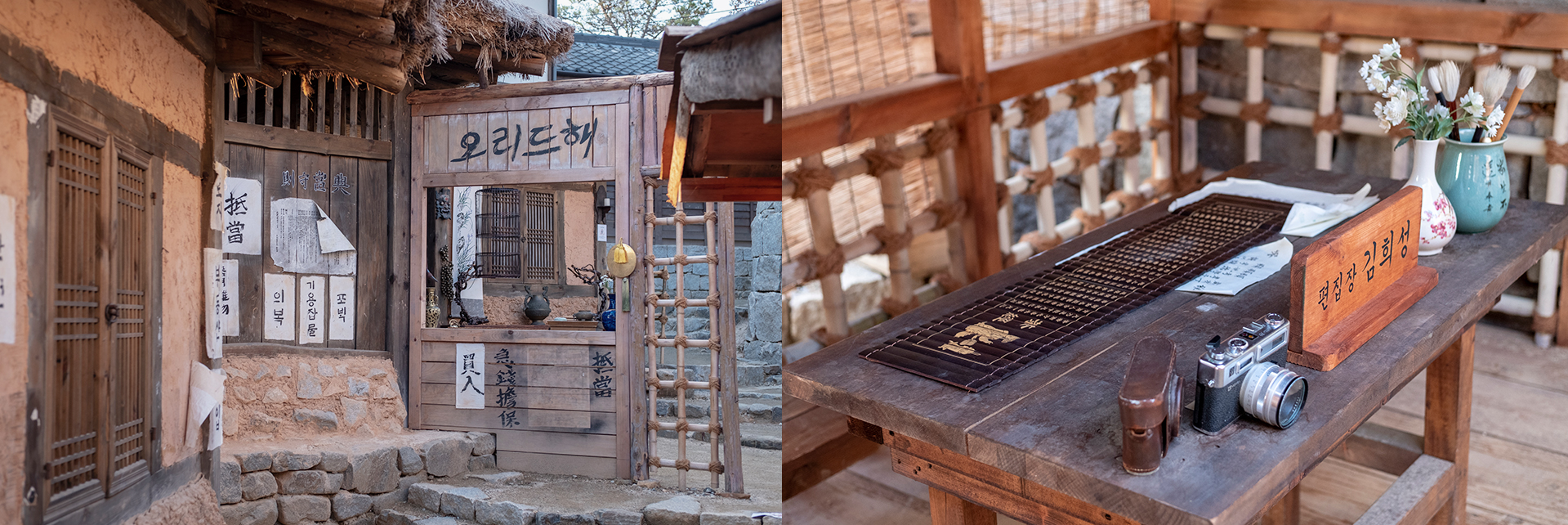
VOL.47 · December 28 · 2018
Trip
Goodbye Mr. Sunshine,
Welcome Sunshine Studio
Sunshine Land
Sunshine Land, an outdoor studio set of <Mr. Sunshine>, a much-beloved Korean drama series that ended last September, has opened. The studio was packed with fans who could not get over the emotional resonance even though the drama had finished. Although <Mr. Sunshine> was shot in various other locations too, this Sunshine studio is a set dedicated to the series, with major shooting spots you can easily recognize from the drama. In Sunshine Studio, let's go on a journey to the era of the late Joseon Dynasty, following the traces of the protagonists who lived in a time of upheaval in the face of Japanese colonialism.
01
“I have been waiting for you”
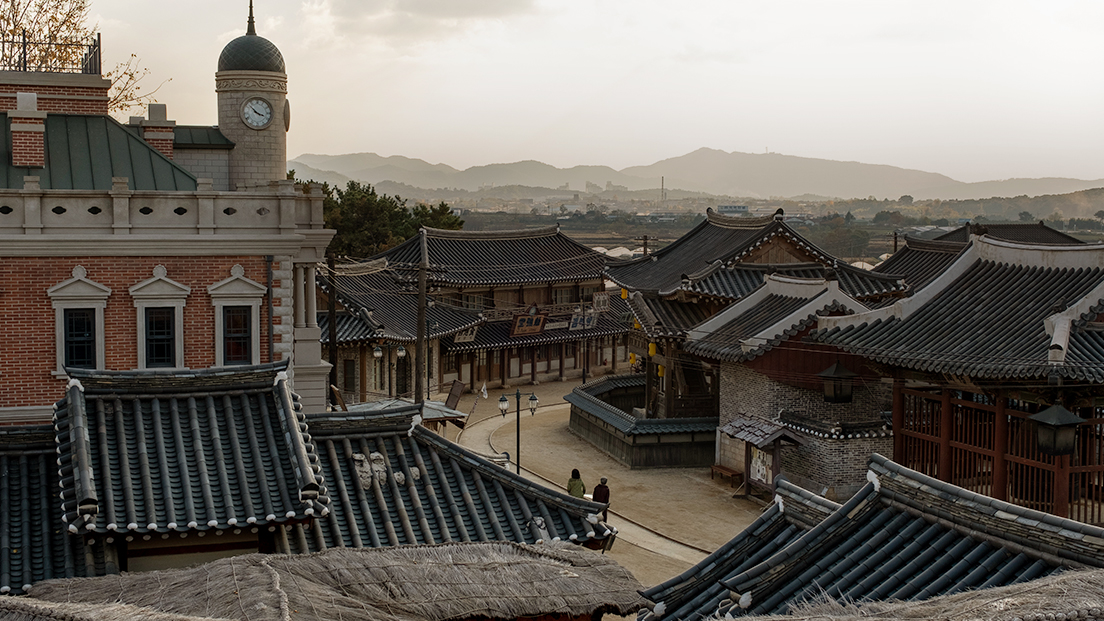
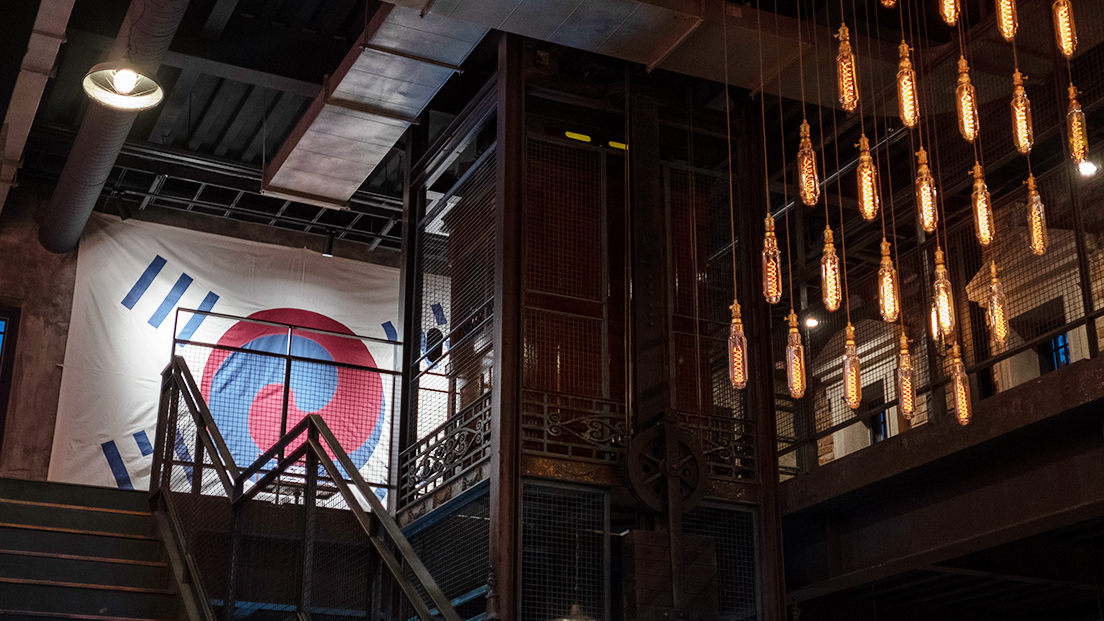

Sunshine Land, one of the hottest tourist spots now in Nonsan, Korea, has opened: it is a real-world drama set studio for <Mr. Sunshine>, a much-beloved drama series that ended last September. Many of its fans who want to see the filming locations of the drama have been flocking to the studio lately.
The first place you run into after passing the ticket office is the streets of Hanseong (the former name of Seoul) in the 1890s, with hanoks (traditional Korean-style house) and thatched houses. The scenery, in which tourists take pictures under fortress walls, brings an illusion that the present and the past coexist. Walking through the fortress and passing Bosinkak Pavillion, glancing about as if you are a time-traveler, you can come across the building of the Seoul Electric Company, the first ever national firm in Korea established in 1898 by the royal family of the Joseon Dynasty and Collbran & Bostwick. Seoul Electric Company helped distribute electricity and trams in Seoul. The building was known to have a bell tower, and the studio set mimicked the original form of the building, including the bell tower.
Entering the building, visitors are welcomed with an exhibition titled “Light and Sensibility” on the 1st floor. The theme of the exhibition is the light bulb, the second ‘fire’ discovered by mankind. On the 2nd floor, the“Mr. Sunshine” exhibition is on, showing the process of production of the series. Next to the exhibition hall is the office of Eugene Choi, one of the main characters of the drama.
On the opposite side of Seoul Electric Company, you can see Bosinkak Pavilion, famous for its bell-ringing ceremony held at the end of the year. The shape of the building, though, looks different from the original one in Seoul. Although it was established in 1396, the building was destroyed four times and then restored eight times, going through many historical upheavals. The building was originally named Jongnu (Korean word for ‘Bell Tower’), but Emperor Gojong renamed it ‘Bosinkak’. ‘Sin’ in Bosinkak came from Ineuiyejisin, the five virtues of the Confucianism meaning benevolence, righteousness, propriety, wisdom and sincerity. The current building was rebuilt with reinforced concrete in the 1980s. Bosinkak Pavilion in Sunshine Studio, however, was modeled after the one in the 1900s, before the recent restoration.
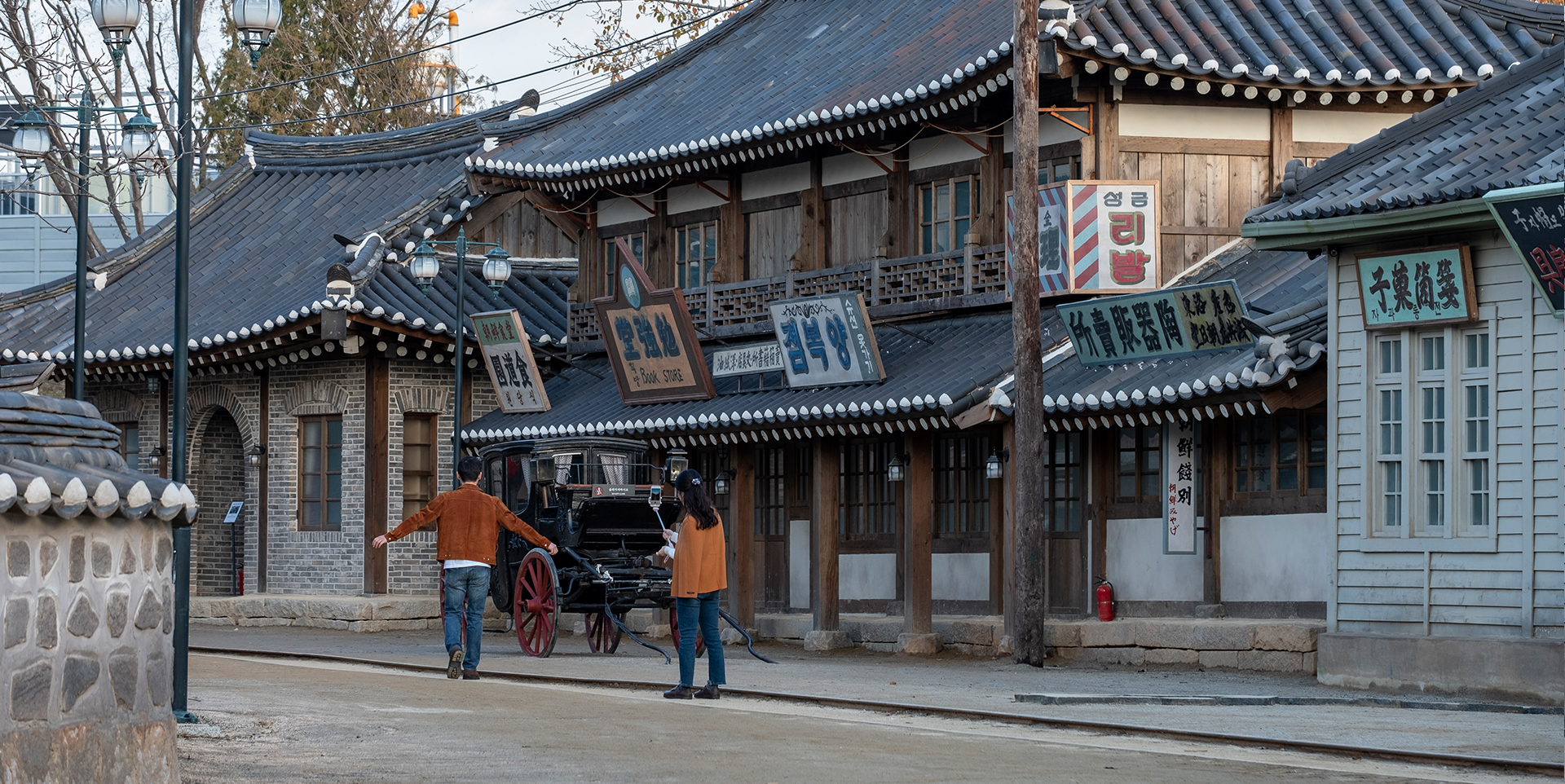
02
“I’ve prepared this for you”


As soon as you pass Bosinkak, the Hwawollu pavilion welcomes you. The Hwawollu pavilion is a place run by Koo Dong-mae, one of the main characters of the series. Born as a son of a butcher, one of the lowest positions in Joseon Dynasty’s hierarchical system, Dong-mae went to Japan, leaving a life with constant humiliations and insults behind. The Hwawollu pavilion was a courtesan house he operated after coming back from Japan. In <Mr. Sunshine>, Hwawollu was depicted as a place full of music and the laughter of geishas. Those sounds, however, changed into the noise of sword fights, gun shots, and screams of traitors who betrayed our country as the drama reached its climax.
At the end of the dirt road, showing the theme of the late Joseon Dynasty, you will find an old-fashioned hanok that gives you an illusion that a Yangban, an aristocrat of the Joseon Dynasty, is about to come out at any moment. It was a house where Ko Ae-sin, the heroin of the series, lived. The exterior of her house was filmed in another place (the Old House of Ildu in Hamyang); the indoor scenes were shot in the Sunshine Studio. This place, which seemed to have mimicked the room of a young unmarried woman from yangban family in the Joseon Dynasty, was packed with people taking commemorative photos.
Reflecting the popularity of the drama, there are multiple photo zones throughout Sunshine Studio. Outside the hanok, a tram that the characters often took in the series grabs the attention of visitors. The tram, used in the drama, was modeled after the Hanseong Tram, the second-ever tram launched in Asia in 1899, following Japan. The tram may remind you of the scene where Kim Hui-seong put Ae-sin into the tram, saying “I’ve prepared this for you.” It was an impressive, rather sad scene, as Hui-seong found out that Ae-sin, his fiancé, had joined the unofficial troops fighting against the Japanese army. Worrying about Ae-sin’s safety, Hui-seong could only support and root for her. Unlike the sad mood of the drama, the Hanseong Tram was full of visitors who were happy and excited. An interesting piece of this episode in history: on the day of the opening ceremony of the Hanseong Tram, Emperor Gojong was said to be reluctant to board the tram as he found the tram, decorated with flowers for the ceremony, felt like a bier. The tram ticket was very expensive at that time, the price of the ticket was worth 1 kg of rice. For this reason, some people formed a gye, a traditional form of private fund in which members chip in a certain amount of money and take turns taking the lump sum. Others even wasted their entire fortune on the trams. The Hanseong Tram was operated for about 70 years until 1968.
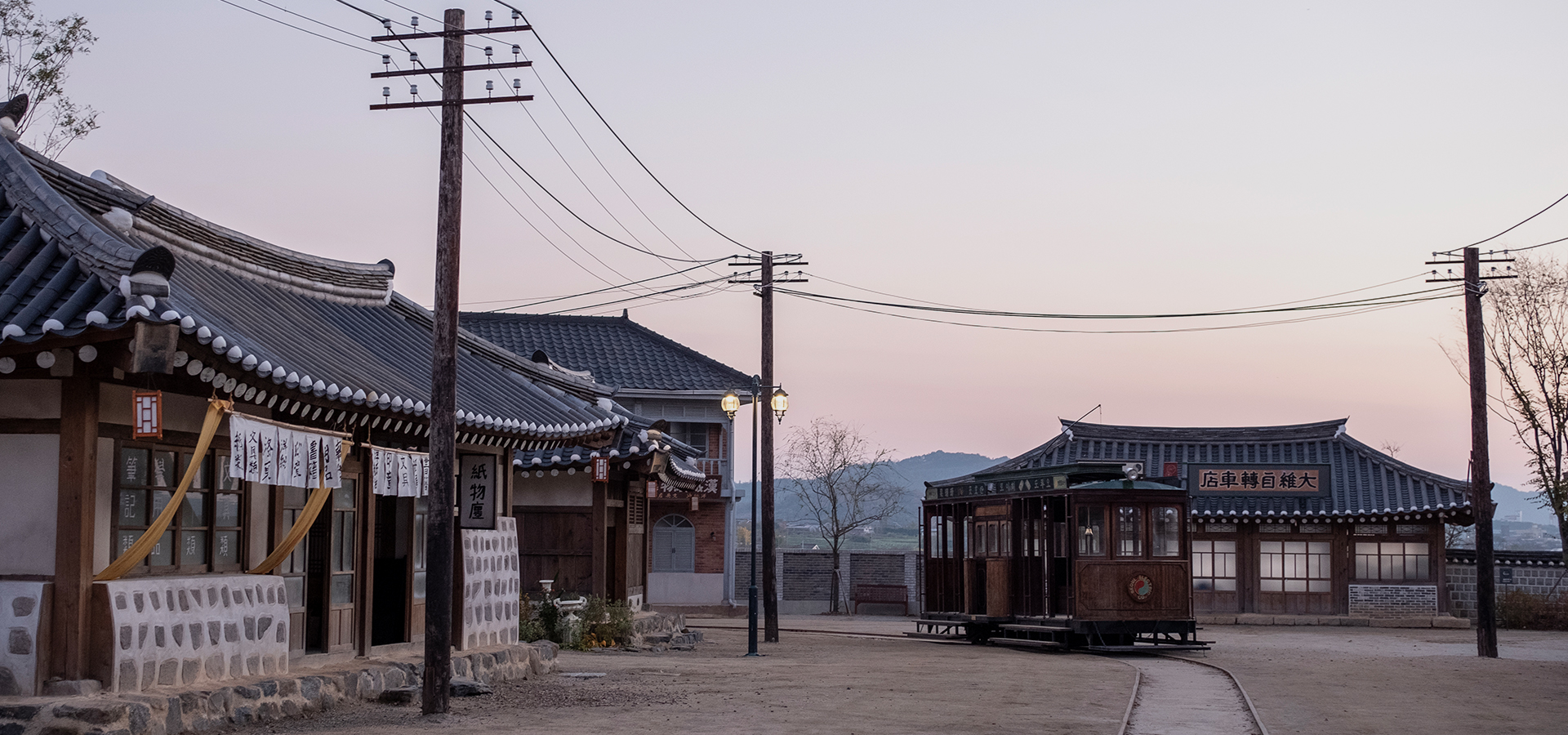
03
Gun, Glory, Sad ending
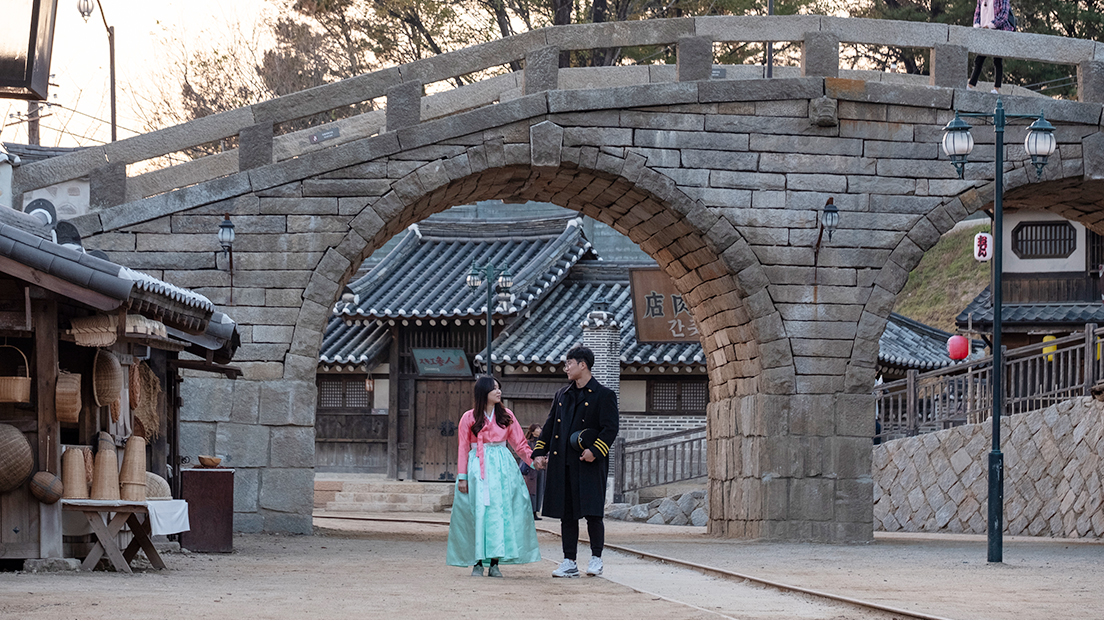
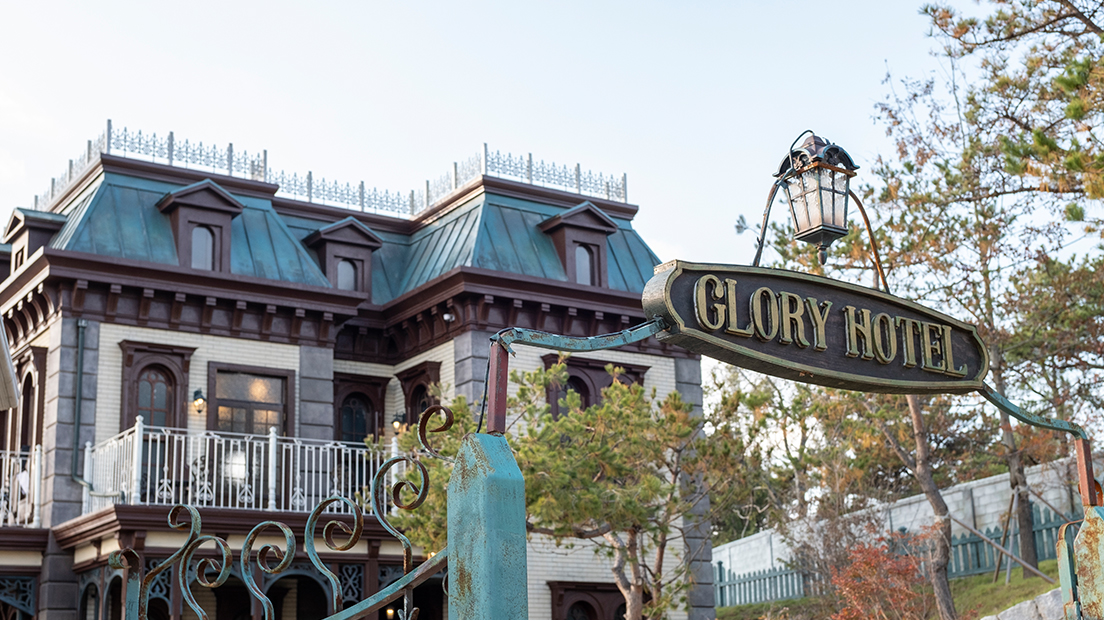
It was almost sunset after browsing around the studio. Yet, there is another important spot you must drop by if you are a fan: the arched stone bridge. This bridge is a place from which all the major events of the drama originate: meetings of the protagonists, fights of the gangsters, revenge on old enemies for parents, and retribution of the Japanese army. On the bridge you can see the entire studio at a glance. There is also a Chinese medicine shop where Eugene Choi and Ae-sin fall in love. The place reminds one of a scene with a red pinwheel and the protagonists putting a love letter in a drawer there.
After passing the bridge, you come across a popular photo zone with a long line of visitors: The Glory Hotel. It was a hotel operated by Kudo Hina who was born as the daughter of a traitor. The hotel, in the series, was blown up with many Japanese soldiers staying in it. The hotel set was blown up too during the actual shooting and rebuilt for the opening of the Sunshine Studio. The Glory Hotel is a gathering place frequented by the ‘enlightened’ individuals, including Eugene Choi, the pro-Japanese Koo Dong-mae, and the hobo Kim Hee-sung. On the first floor of the Hotel, a variety of small items and MD products used for the drama are sold. There is a coffee shop named ‘Gabaejeong’ on the second floor where the protagonists used to meet and have a cup of coffee.
The last stop was Haedrio, a type of pawnshop in the Joseon Dynasty. In the drama, however, it served as a private detective agency. The name Haedrio (pun intended) originated from the Korean expression of “We will do everything for you (“Da Haedrio” in Korean).” As the ‘arm-twisters’ working in the shop did everything for their clients from A to Z, the shop is full of small and interesting items. At one corner you could find a desk of Kim Hui-seong, who operated a small newspaper agency within the shop.
<Mr. Sunshine> has come to a tragic end, with the last theme of “Gun, Glory, and Sad ending”. If you are still lingering on its sad ending, I recommend you visit the Sunshine Studio. Sunshine Land would be a good place for a refreshing outing, with the Military Experience Center and a studio set reenacting the 1950s of Korea accompanying the Sunshine Studio.
